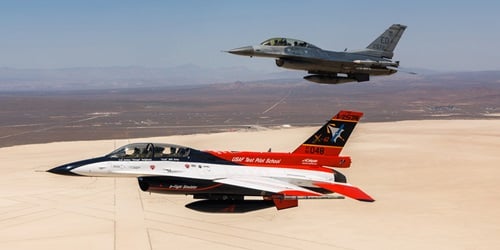Agility Matters: Accelerating Aerospace Autonomy

Cross-Industry Collaboration Needed to Advance Autonomous Systems in Air & Space
By Greg Zacharias, Aerospace R&D Domain Lead and Executive Producer, AIAA SciTech Forum
Agility matters when designing new capabilities like autonomous aircraft. So does thinking and partnering non-traditionally—it can lead to breakthroughs.
Who would have thought that the Secretary of the U.S. Air Force would fly on a X-62 VISTA fully controlled by a neural network? By working outside the box, the Air Force Research Laboratory (AFRL) and DARPA partnered together and pulled it off in only five years, not decades.
For the latest flight test in May, U.S. Air Force Secretary Frank Kendall flew on the aircraft, configured to behave like an F-16, where the modified fighter jet performed dogfighting maneuvers autonomously on par with an experienced F-16 pilot.
The feat left an impression on
Hobbs is part of AFRL’s Autonomy Capability Team (ACT 3),
Hobbs hopes to bring this same spirit of collaboration in aerospace autonomy to a new cross-industry task force.
New Roadmap for Aerospace Autonomy
The American Institute of Aeronautics and Astronautics (AIAA) Autonomy Task Force brings together all sectors of the industry—large and small commercial companies, government agencies, and academia—to drive faster and better collaboration in autonomy innovation across the air and space domains.
Its initial focus includes three key functions of autonomous systems: sensing and perception; reasoning and acting, such as verifying that an autonomous entity performed within its delegated and bounded authority; and collaboration and interaction. In this last functional area, multiple autonomous agents such as a constellation of space vehicles may work together to navigate around each other.
The timing couldn’t have been better with the rise in advanced air mobility, a growing commercial presence in space, and rapid developments in defense systems.

Defining Autonomy in Aerospace
What is meant by aerospace autonomy? There isn’t an agreed-upon definition across the industry.
The task force’s working definition is “a robotic air or space system set to achieve goals with delegated and bounded authority while operating independently or with limited external control.”
Unlike traditional robotics that perform a single task, today’s autonomous vehicles need to be adaptive to a broken tread or a flash of sunlight on a sensor, but not so independent that the system would deviate and compromise the mission.
The emphasis is on setting a boundary around what the autonomous system is allowed to do and how it’s allowed to operate.
Speed and Lessons from Aerospace
A key research gap that the task force hopes to address is in the area of verification and validation (V&V) systems and processes that are cost-effective to implement. While the space domain has a long history of conducting extensive V&V of semiautonomous systems, the air domain is gaining ground in part because of the test opportunities, where getting a quadcopter or a small UAV or even an F-16 is significantly cheaper than procuring a space vehicle for an autonomy test. “Your opportunities to test are few and far between,” says Hobbs of the space environment.
The current pace of autonomous system development remains a major concern for Hobbs. Even witnessing the AI-enabled F-16 test flight, which occurred on the AFRL’s VISTA test platform, pinpointed the limitations of current testing.
“I realized everything I knew about
Lessons from Computing
Aerospace autonomy builders also should embrace the computing industry’s market approaches that focus on the idea of a “minimal viable product,” says Hobbs.
Instead of ensuring that all requirements are correct in the beginning of a program, teams can make a small investment as fast as possible to get from the requirements and development phases to ground and flight simulations more quickly. In this way, groups can learn quickly and iterate better autonomous system designs.
High Stakes for Getting Autonomy Right
Much is riding on getting aerospace autonomy right.
“We need a strategy to fully harness these technologies. Without it, we risk other countries moving ahead,” warns Hobbs, noting that unequal access to autonomy breakthroughs within the commercial sector could also harm U.S. competitiveness.
“The goal is for aerospace to continue to evolve. It’s going to take a tight-knit community across big industry, small industry, government, and academia working together to speed up the development process to catch up to other industries,” she concludes.
###
Featured Photo: Dr. Kerianne Hobbs, Safe Autonomy and Space Lead, AFRL. (Photo: AFRL)
The AIAA Autonomy Task Force will present its position paper highlighting key challenges and defining near-term research needs to advance the state of the art in autonomy during the 2025 AIAA SciTech Forum, 6–10 January 2025 in Orlando, Florida. Hear their findings and more on many cutting-edge topics in aerospace R&D at the forum. Learn more and register at aiaa.org/scitech.




